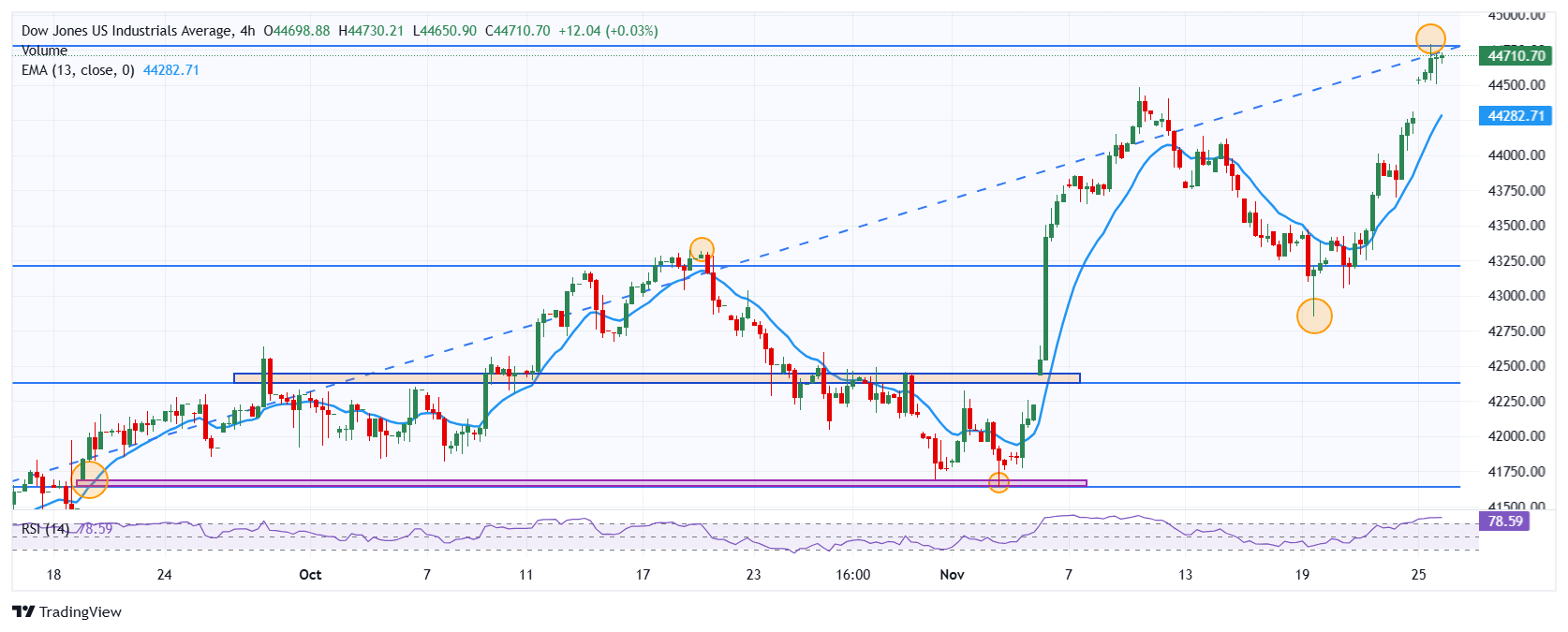- The Dow Jones rises 1.01% today.
- The Nasdaq 100 rises 0.18% on the day.
- The S&P 500 gains 0.35% in Monday’s session.
The Dow Jones hit a new all-time high of 44,793 following the nomination of Scott Bessent as Treasury Secretary under President-elect Donald Trump’s administration.
The Dow Jones Industrial Average began trading at 44,538, while the Nasdaq 100 technology index began the day at 20,895. The S&P 500 opened at 5,995, marking its third consecutive session with gains.
Sherwin-Williams and Boeing take the Dow Jones to all-time highs
The Dow Jones Industrial Average is trading at the time of writing above 44,710, rising 1.01% on the day, establishing new all-time highs at 44793, to sign its fourth consecutive session on the rise.
The world’s leading commercial aircraft manufacturer, Boeing (BA), has seen its share price increase by 2.55% today, currently trading above $153.10, reaching highs not seen since November 5 at 153.28. $. In the same vein, Sherwin-Williams (SHW) shares established a new all-time high at $400.29, registering a gain of 2.94% at the market close.
Super Micro Computer leads gains on Nasdaq 100
The Nasdaq 100 technology index gained 0.18% at the close of the session on Monday, trading at 20,805 at the time of writing.
Super Micro Computer (SMCI) shares maintain their bullish outlook and record their third consecutive session with double-digit gains as they conclude Monday’s session with an increase of 15.87% in their share price. At the time of writing, SMCI is trading at $38.41, reaching October 30 levels.
On the other hand, DexCom (DXCM) shares gained 6.87% today, reaching highs not seen since November 25 at $78.22, in line with Moderna (MRNA) shares, which gained 6.20% at the beginning of the week, reaching highs not seen since November 11 at $46.30.
S&P 500 rises after appointment of next Treasury Secretary
The S&P 500 stock index is trading at 5.986 at the end of trading on Monday, rising 0.35% daily, following President-elect Donald Trump’s announcement to name Scott Bessent as the next Treasury Secretary. The market has taken this news as an intention to reduce public spending with the aim of reducing inflation.
In this context, investors will have their eyes on the publication of the Fed Minutes tomorrow, it is expected that the monetary authority will clarify the pace of interest rate reduction in the short term.
The United States economic agenda considers the housing price index, consumer confidence, PCE core and the Gross Domestic Product to be published later in the week.
Technical analysis of the Dow Jones
The Dow Jones established short-term support given by the November 19 low at 42,850. The next key support area is seen at 41,641, the pivot point of November 4. To the upside, we look at the 45,550 area as potential investor profit-taking, in convergence with the 1.27% Fibonacci extension.
Dow Jones 4-hour chart

The Dow Jones FAQs
The Dow Jones Industrial Average, one of the world’s oldest stock indices, is made up of the 30 most traded securities in the United States. The index is weighted by price rather than capitalization. It is calculated by adding the prices of the securities that comprise it and dividing them by a factor, currently 0.152. The index was founded by Charles Dow, also founder of the Wall Street Journal. In recent years it has been criticized for not being sufficiently representative, since it only follows 30 companies, unlike broader indices such as the S& P 500.
There are many factors that drive the Dow Jones Industrial Average (DJIA). The main one is the aggregate performance of its component companies, revealed in quarterly corporate earnings reports. US and global macroeconomic data also contribute, influencing investor sentiment. The level of interest rates, set by the Federal Reserve (Fed), also influences the DJIA, as it affects the cost of credit, on which many companies largely depend. Therefore, inflation can be a determining factor, as well as other parameters that influence the Federal Reserve’s decisions.
The Dow Theory is a method for identifying the main trend of the stock market developed by Charles Dow. A key step is to compare the direction of the Dow Jones Industrial Average (DJIA) and the Dow Jones Transportation Average (DJTA) and only follow trends where they are both moving in the same direction. Volume is a confirmation criterion. The theory uses elements of maximum and minimum analysis. The Dow theory proposes three phases of the trend: accumulation, when the smart money begins to buy or sell; public participation, when the general public joins the trend; and distribution, when the smart money abandons the trend.
There are several ways to trade the DJIA. One of them is to use ETFs that allow investors to trade the DJIA as a single security, instead of having to buy shares of the 30 companies that comprise it. A prominent example is the SPDR Dow Jones Industrial Average ETF (DIA). Futures contracts on the DJIA allow traders to speculate on the future value of the index, and options provide the right, but not the obligation, to buy or sell the index at a predetermined price in the future. Mutual funds allow investors to purchase a portion of a diversified portfolio of DJIA securities, providing exposure to the global index.
Source: Fx Street
I am Joshua Winder, a senior-level journalist and editor at World Stock Market. I specialize in covering news related to the stock market and economic trends. With more than 8 years of experience in this field, I have become an expert in financial reporting.







